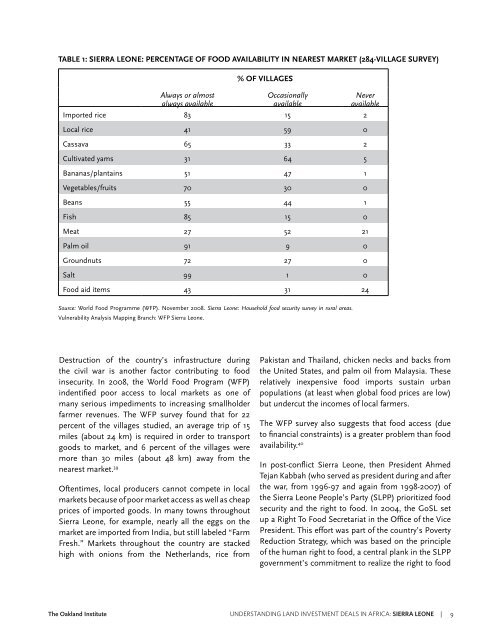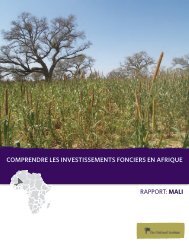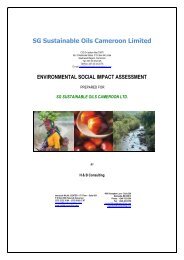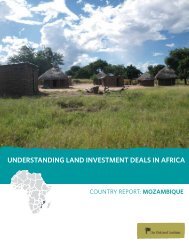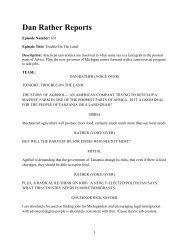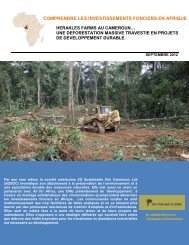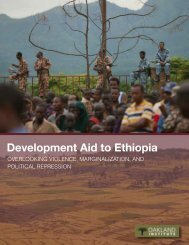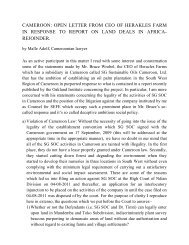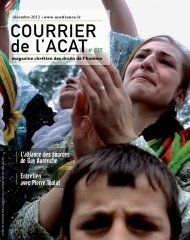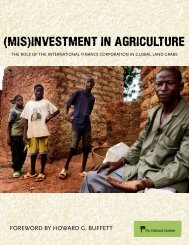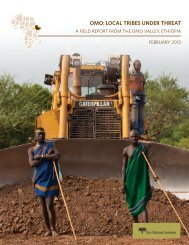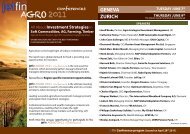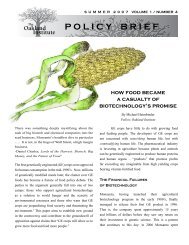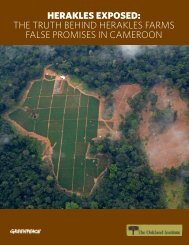Country Report: Sierra Leone - Oakland Institute
Country Report: Sierra Leone - Oakland Institute
Country Report: Sierra Leone - Oakland Institute
You also want an ePaper? Increase the reach of your titles
YUMPU automatically turns print PDFs into web optimized ePapers that Google loves.
TABLE 1: SIERRA LEOnE: PERCEnTAGE OF FOOD AvAILABILITy In nEAREST MARkET (284-vILLAGE SURvEy)<br />
Destruction of the country’s infrastructure during<br />
the civil war is another factor contributing to food<br />
insecurity. In 2008, the World Food Program (WFP)<br />
indentified poor access to local markets as one of<br />
many serious impediments to increasing smallholder<br />
farmer revenues. The WFP survey found that for 22<br />
percent of the villages studied, an average trip of 15<br />
miles (about 24 km) is required in order to transport<br />
goods to market, and 6 percent of the villages were<br />
more than 30 miles (about 48 km) away from the<br />
nearest market. 39<br />
Oftentimes, local producers cannot compete in local<br />
markets because of poor market access as well as cheap<br />
prices of imported goods. In many towns throughout<br />
<strong>Sierra</strong> <strong>Leone</strong>, for example, nearly all the eggs on the<br />
market are imported from India, but still labeled “Farm<br />
Fresh.” Markets throughout the country are stacked<br />
high with onions from the Netherlands, rice from<br />
% OF vILLAGES<br />
Always or almost Occasionally Never<br />
always available available available<br />
Imported rice 83 15 2<br />
Local rice 41 59 0<br />
Cassava 65 33 2<br />
Cultivated yams 31 64 5<br />
Bananas/plantains 51 47 1<br />
Vegetables/fruits 70 30 0<br />
Beans 55 44 1<br />
Fish 85 15 0<br />
Meat 27 52 21<br />
Palm oil 91 9 0<br />
Groundnuts 72 27 0<br />
Salt 99 1 0<br />
Food aid items 43 31 24<br />
Source: World Food Programme (WFP). November 2008. <strong>Sierra</strong> <strong>Leone</strong>: Household food security survey in rural areas.<br />
Vulnerability Analysis Mapping Branch: WFP <strong>Sierra</strong> <strong>Leone</strong>.<br />
Pakistan and Thailand, chicken necks and backs from<br />
the United States, and palm oil from Malaysia. These<br />
relatively inexpensive food imports sustain urban<br />
populations (at least when global food prices are low)<br />
but undercut the incomes of local farmers.<br />
The WFP survey also suggests that food access (due<br />
to financial constraints) is a greater problem than food<br />
availability. 40<br />
In post-conflict <strong>Sierra</strong> <strong>Leone</strong>, then President Ahmed<br />
Tejan Kabbah (who served as president during and after<br />
the war, from 1996-97 and again from 1998-2007) of<br />
the <strong>Sierra</strong> <strong>Leone</strong> People’s Party (SLPP) prioritized food<br />
security and the right to food. In 2004, the GoSL set<br />
up a Right To Food Secretariat in the Office of the Vice<br />
President. This effort was part of the country’s Poverty<br />
Reduction Strategy, which was based on the principle<br />
of the human right to food, a central plank in the SLPP<br />
government’s commitment to realize the right to food<br />
The <strong>Oakland</strong> <strong>Institute</strong> understanding land investment deals in afriCa: sierra <strong>Leone</strong> | 9


